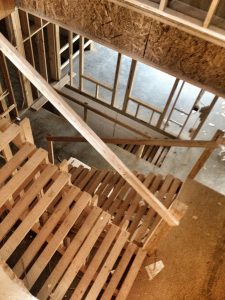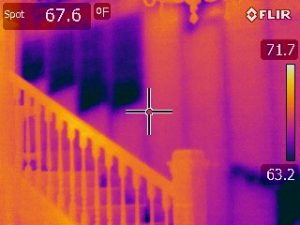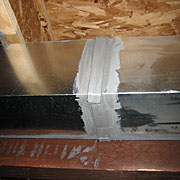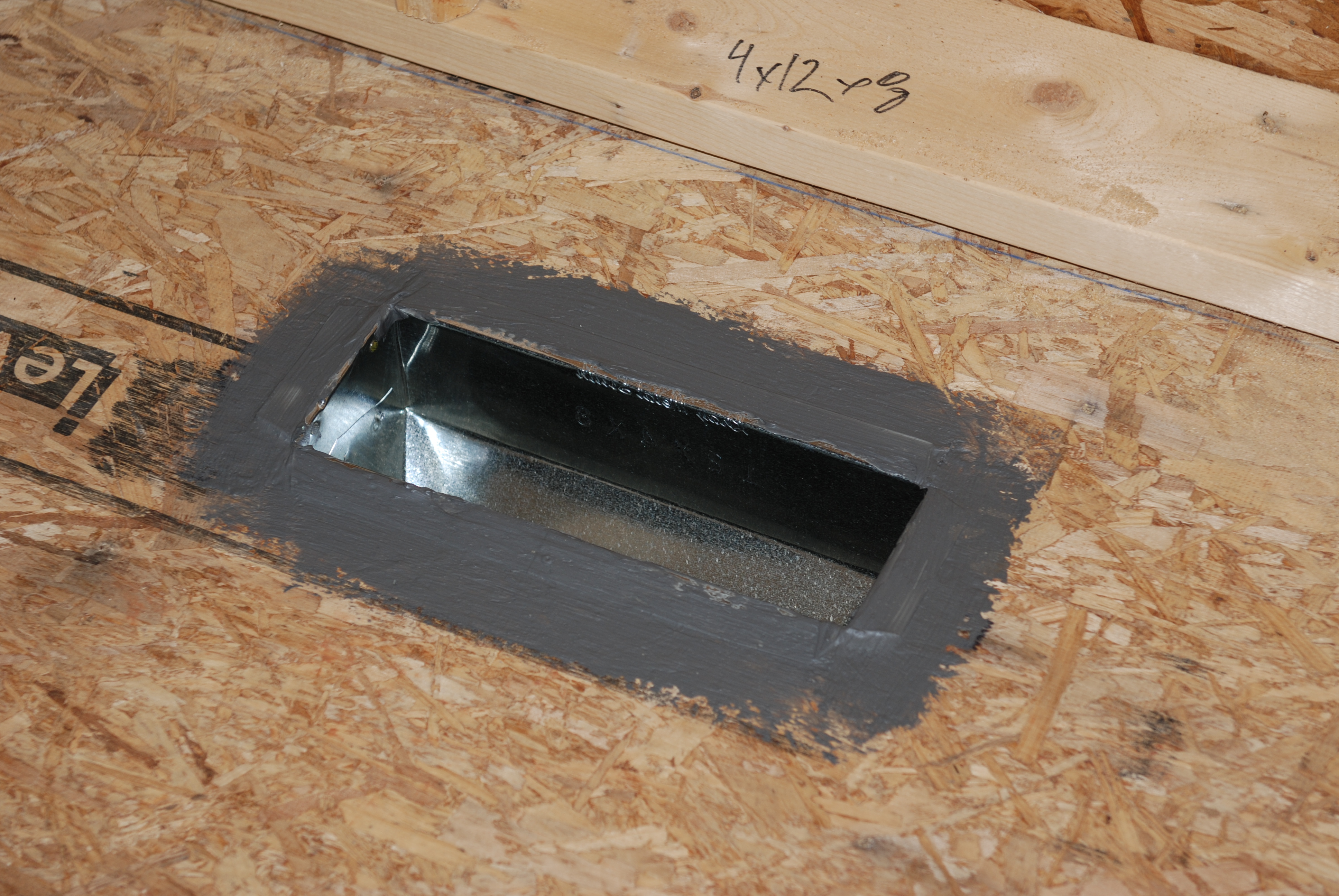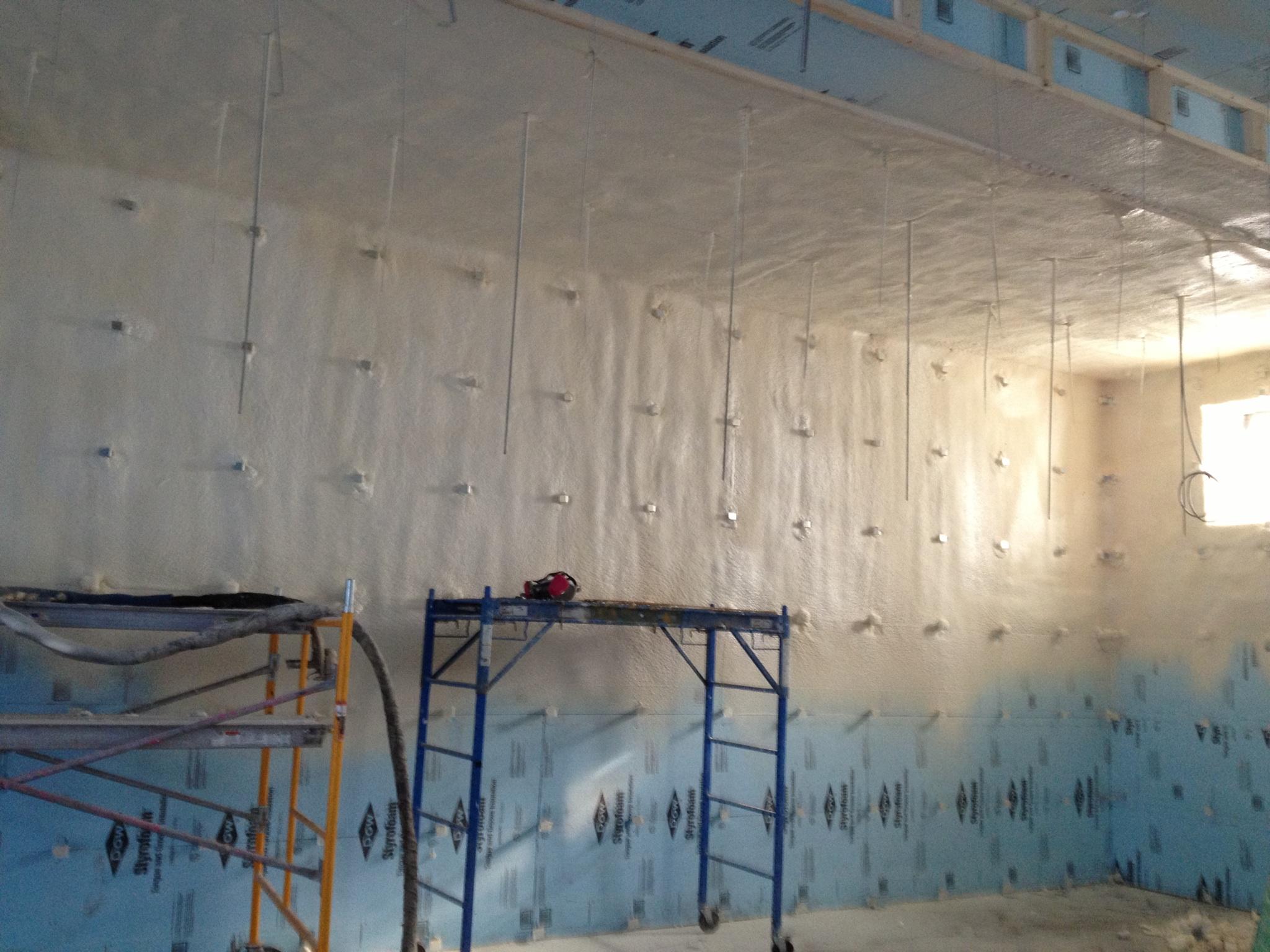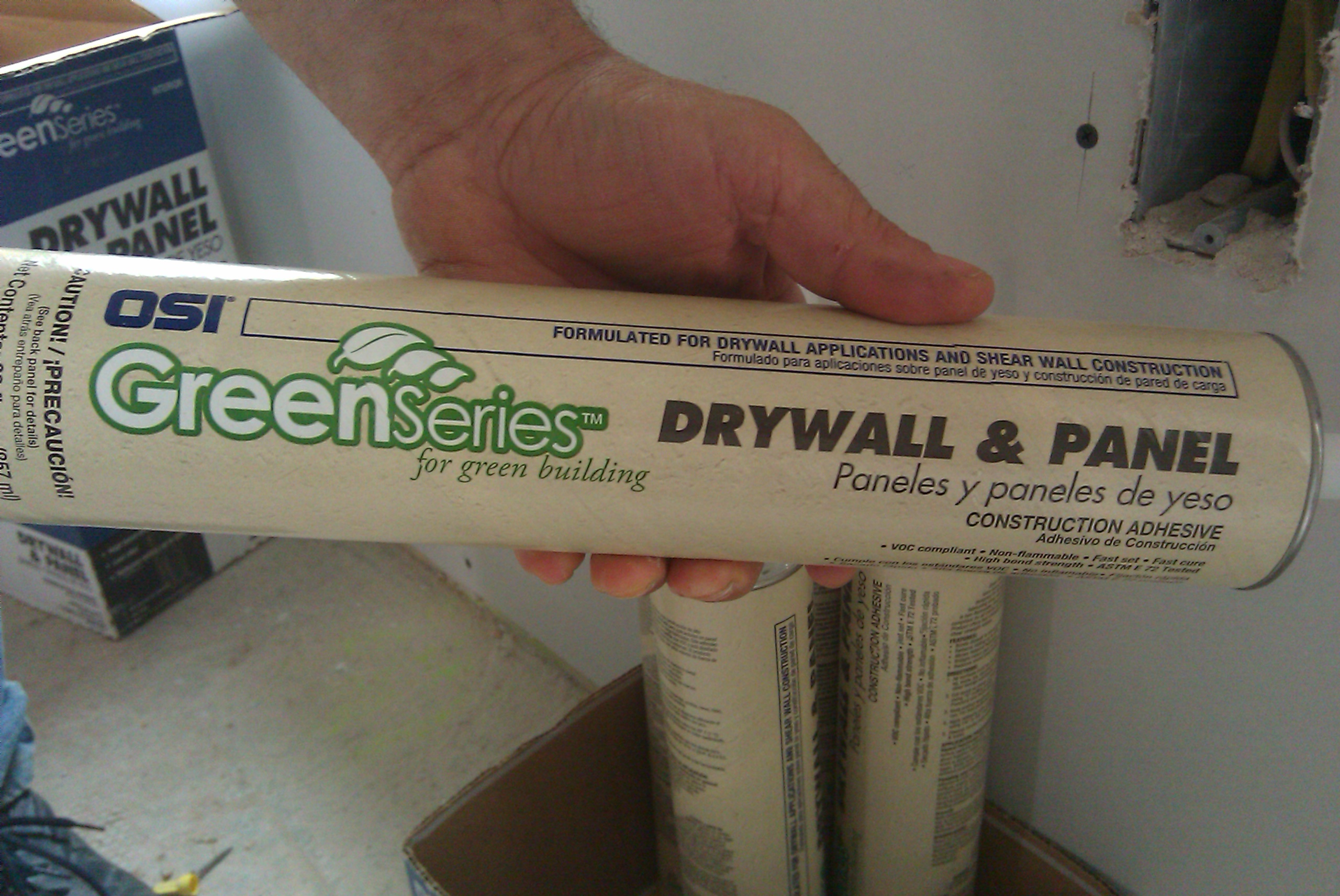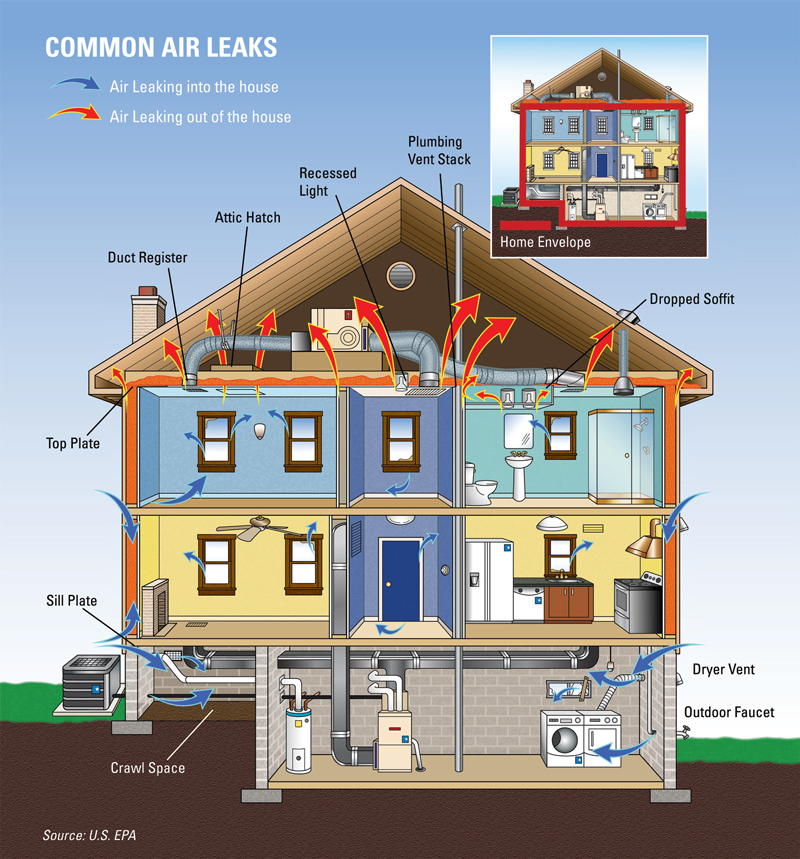by harrisonburgarchitect | Jan 7, 2014 | architecture, Building Science, Indoor Air Quality
Following up on the blog question posted yesterday. This is a photo taken between a vented attic and a conditioned space. The dirty line at the bottom of the insulation shows the path of air infiltration from conditioned to unconditioned space. This is a typical problem in buildings that do not have proper air sealing. Fiberglass insulation works well as an insulator but does not stop air movement. The insulation becomes an air filter without an air barrier. Air movement also brings vapor movement. Once the insulation gets wet it loses all effectiveness. There is also a chance that the moisture movement will be enough to support mold growth. If you find that your insulation is acting as an air filter and not insulating – making the space air tight will solve the air quality and energy-efficiency issue.
More information on Air Sealing, click here, here, and here.
by harrisonburgarchitect | Jan 6, 2014 | architecture, Building Science, Harrisonburg Architect, Indoor Air Quality
This is a photo I took between an unfinished vented attic space and a finished conditioned space. What building science issues do you see?
Answers to follow in tomorrows blog.
by harrisonburgarchitect | Dec 16, 2013 | architecture, Building Science, Harrisonburg Architect, Indoor Air Quality
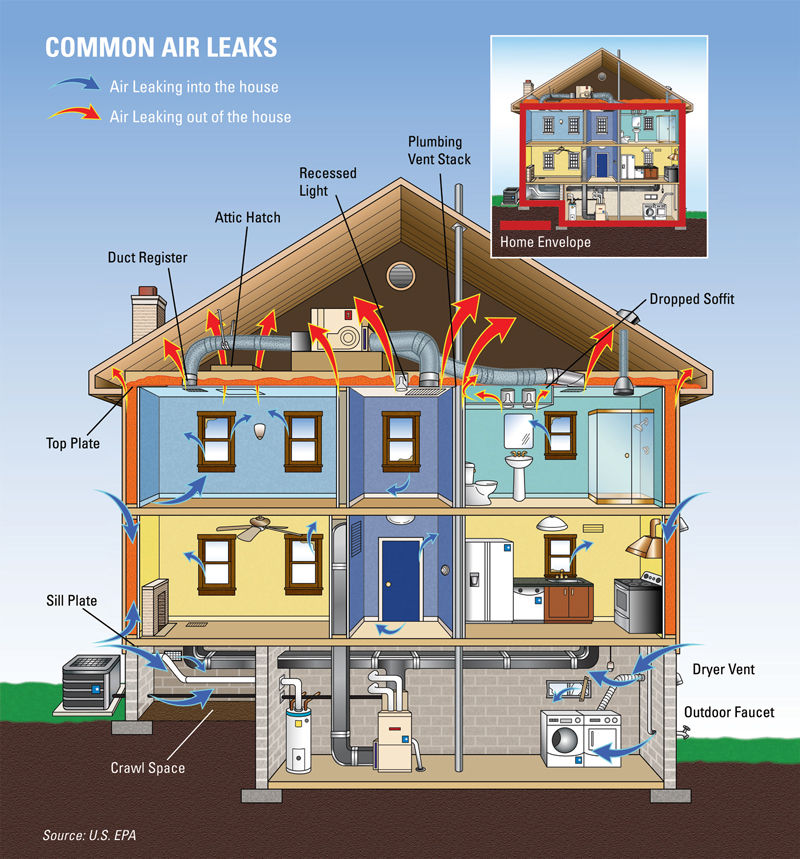 Most of us know the miles-per-gallon of our cars. I just went through (for me) the very painful process of purchasing a new (used) car. I weighed the options looking at asking price, insurance premium, maintenance costs, and miles per gallon. These should all be factors when purchasing or building a new home. However, we almost never know the miles per gallon equivalent for a building. That is because a HERS rating is not required in Virginia. It is however, a test that is easy to request as part of your evaluation process for existing homes or performance criteria for new construction.
Most of us know the miles-per-gallon of our cars. I just went through (for me) the very painful process of purchasing a new (used) car. I weighed the options looking at asking price, insurance premium, maintenance costs, and miles per gallon. These should all be factors when purchasing or building a new home. However, we almost never know the miles per gallon equivalent for a building. That is because a HERS rating is not required in Virginia. It is however, a test that is easy to request as part of your evaluation process for existing homes or performance criteria for new construction.

A home energy rating is an analysis of the efficiency of the home’s energy usage. The Home energy Rating System (HERS) is the nationally recognized scoring system for measuring a home’s energy performance. The results of the test give you a HERS Index Score. This miles-per-gallon for your home allows you to compare how your home is performing vs a baseline accepted standard. The test and report also gives you a checklist of areas that could use attention to improve your homes performance.
For more information read here, here, and here.
by harrisonburgarchitect | Dec 13, 2013 | architecture, Building Science, Harrisonburg Architect, Indoor Air Quality
 I respond to a lot of requests for proposals and do a lot of interviews for new design projects. Sometimes there is a higher standard to which the new design needs to meet, and sometimes the potential project is only aiming for building code minimum standards. What quality do you want for your home / business?
I respond to a lot of requests for proposals and do a lot of interviews for new design projects. Sometimes there is a higher standard to which the new design needs to meet, and sometimes the potential project is only aiming for building code minimum standards. What quality do you want for your home / business?
When you start planning your new commercial building, home, or renovation project, what standard will you set for the construction? Many people assume that building code is a good standard that will deliver a quality project. They also assume that if a building “meets code,” it will perform well over time, be efficient, and be durable.

Unfortunately, that is not the goal of the building code. The building code is a reactive document that is modified over time (in Virginia every 3 years) very slowly to protect the health, safety, and welfare of the general public as a minimum standard. The standards in the code come from failures that have been identified in the past and serve as a way to protect against repeating those same failures. There is a lot of information about structural needs in a building. There is a heavy focus on fire safety. Building code even sets some very minimum standards for energy usage. However, setting the building code as a standard for your projects structural performance will not deliver a home that prevents the china from rattling as you walk past. It is a minimum standard that will simply deliver a project that is structurally safe. If you want a building that is energy-efficient, the building code is not a place to look for standards. This is again, a minimum guideline that does not look at the interconnections between systems and the performance of a building. You can construct a code compliant building that costs you a fortune to maintain each month that is almost never comfortable. You can construct a code minimum building that has low performance, unhealthy indoor air, and high energy bills.

When you are planning your next building, it is important to ask yourself some key questions:
What is your goal for energy usage?
How much maintenance will you find acceptable?
How much “bounce” is acceptable in your floor system?
What kind of priority is the indoor air quality?
These are all questions that building to code will be delivered at a very minimal level. Some of these questions address quality issues and some are systems coordination. A high performance building should be a goal for all of us. Evaluate all the building standards available or hire someone that understands these systems to help set the standards. Using LEED and EarthCraft is a good start to help you evaluate your goal, but don’t stop there. Look beyond these rating systems and think about what comfort you desire in your project. This is where you will make some really valuable decisions about quality and priority. If you want a building that is energy-efficient, healthy, and durable, code minimum is not the answer.
by harrisonburgarchitect | Dec 9, 2013 | architecture, Building Science, Harrisonburg Architect, Indoor Air Quality
In a home with a forced-air heating and cooling system, the system used to distribute air is called duct work. In an average home, 30% of the air sent through the duct work system is lost due to leaks, holes, and poorly executed connections. The result to your wallet is higher electric bills and lower comfort.

The best way to seal up these ducts during construction is using a paint on mastic or mastic tape. While other tapes fail over time, Mastic stays stuck to your ducts creating an air tight air distribution system.
The benefits of a tight air duct system include comfort, indoor air quality improvements, lower electric bills, and a reduced impact on the environment.

For more information on improving your heating and cooling system, click here and here.
by harrisonburgarchitect | Nov 25, 2013 | architecture, Building Science, Harrisonburg Architect, Indoor Air Quality

During Construction
Air sealing is the first line of defense against wasting energy in your home and protecting your indoor air quality. Air sealing is the practice of filling all those gaps, cracks, and holes in your thermal envelope. This tightens the home’s air pressure giving you a solid thermal envelope.

Air sealing is the most effective way to reduce energy consumption in your home. It will also help protect indoor air quality in your home and the durability of your building materials. In a typical home, air leaks through walls, crawl spaces, attic, around windows, and doors. This air is not filtered and leads to dust particles and potentially dangerous chemicals in the indoor air. Making your home air tight also stops moisture moving through building materials. Bulk moisture migrating through building materials could lead to rot or mold growth.
The most common materials used to air seal your home is a latex or silicone caulk. Other materials that can be used include expanding foams, weatherstripping, or dense insulation materials like cellulose. Done right with a holistic approach to building science, these strategies help create a high performance building solution.


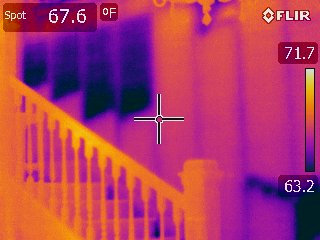
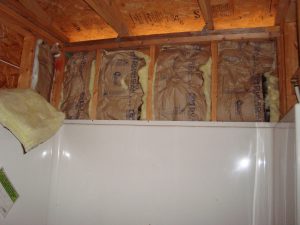 I respond to a lot of requests for proposals and do a lot of interviews for new design projects. Sometimes there is a higher standard to which the new design needs to meet, and sometimes the potential project is only aiming for building code minimum standards. What quality do you want for your home / business?
I respond to a lot of requests for proposals and do a lot of interviews for new design projects. Sometimes there is a higher standard to which the new design needs to meet, and sometimes the potential project is only aiming for building code minimum standards. What quality do you want for your home / business?